
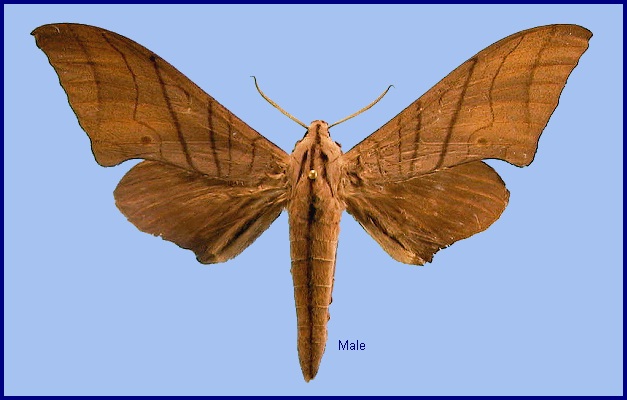
Triptogon cristata Butler, 1875, Proc. zool. Soc. Lond. 1875: 253. Type locality: [India, West Bengal,] vicinity of Darjeeling.
Synonym. Triptogon cristata Butler, 1875.
Synonym. Marumba cristata ochrea Mell, 1922.
Synonym. Marumba cristata jodeides Clark, 1937.
Note. DNA barcode evidence suggests that all mainland Chinese populations referred to as Marumba cristata cristata may be Marumba cristata titan Rothschild, 1920, which 'extends' from NE India (Assam), SW, SE and E China, Burma, Thailand and Vietnam down to Peninsular Malaysia and Sumatra, Indonesia. True Marumba cristata cristata appears to be confined to north and west of the Brahmaputra River (Arunachal Pradesh (India), west through Bhutan, Sikkim and Nepal, to Uttarakhand (India)). However, whether the separation of Marumba cristata titan from the nominotypical subspecies, Marumba cristata cristata, is justified still remains to be confirmed.
Wingspan: 100--124mm. This sombre-coloured insect is very constant and cannot easily be confused with other species. The uniform colour of the upperside, the heavy black mesial line of the body, the simple lines of forewing, the presence of a small creamy stigma on forewing, the absence of the first anal spot from the hindwing, and the rosy tint of the underside separate M. cristata at a glance from the other species of Marumba. Antenna less than one-third length of forewing, thinner than in M. dyras; in male grooved, the seriate basal cilia of the middle segments nearly as long as the segments. Tarsi very stout (Bell & Scott, 1937).
In the male genitalia, uncus deeply divided into two slender, pointed lobes. Gnathos triangular. Valva distinctive in having the dorso-apical lobe pointed and curved upwards and the ventral lobe broad and rounded. Harpe not so strongly curved as in Marumba sperchius and M. dyras, not denticulate and reaching nearer to end of valva. In the female genitalia, sterigma with a long truncate process in front of ostium bursae and a dentate flap on each side.
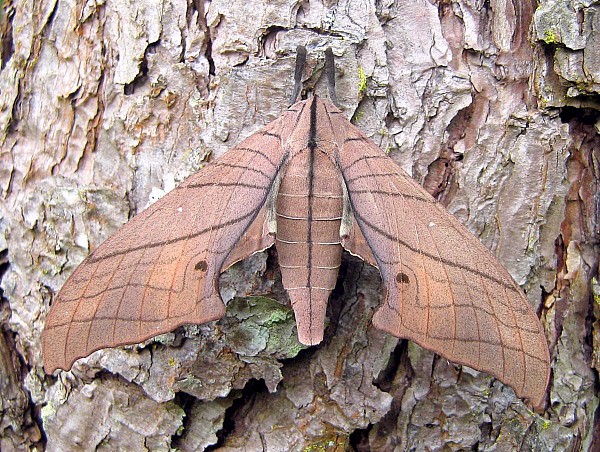
The species occurs in southern China in jungle of mixed bamboo and deciduous trees at 1,500--2,500 feet (Mell, 1922b).
China: ii-iv (Hainan); iv (Fujian); v (Jiangxi; Guangxi; Yunnan; Zhejiang); vi (Xizang/Tibet; Hainan; Hunan; Sichuan; Yunnan); vii (Xizang/Tibet; Jiangxi; Zhejiang); viii (Fujian; Hunan); ix (Sichuan).
OVUM: Ivory-yellow, broadly oval (2.75-3.0 x 2.50 x 2 mm), smooth and shiny (Mell, 1922b).
LARVA: Full-fed 68mm, width 11mm; head 8.5 x 7mm. In the first instar pale yellowish-white, 9-10mm long, with a long and thin dark wine-red horn. The eggshell, but little or no plant material, is consumed during this stage (Eitschberger & Nguyen, 2016d). According to Mell (1922b), in the final instar very similar in shape to that of Marumba dyras; the horn long, straight, the breadth greater than the height in a cross-section. Surface of head and body dull; head with a line of tubercles separating the face from the cheeks. There is a transverse row of small tubercles around each secondary ring, and larger pointed tubercles along the oblique lateral stripes. Horn covered with small tubercles, with small tubercles along the edge of the anal flap and claspers.
In colour, head pale green, with the line of tubercles between the face and cheeks obscurely white; there is also a dark green dorsal stripe from the vertex to the nape. Body pale green with a dark green dorsal stripe to the hind margin of segment 4. The oblique lateral stripes are white, sometimes edged narrowly by red or yellow, and running across three segments; tubercles on the oblique stripes orange. Horn blue-green, the tubercles on the basal half paler and those on the distal half darker than the body colour. The tubercles edging the anal flap and claspers paler than the body colour. True legs dull red banded with dull brown, and sometimes with a dull brown mark at the base; prolegs and clasper pale green. Spiracles oval, the central slit pale in colour, dilated at the top and bottom and with a red-brown band on each side of it (Mell, 1922b).
The colour becomes paler and somewhat translucent-looking before pupation.
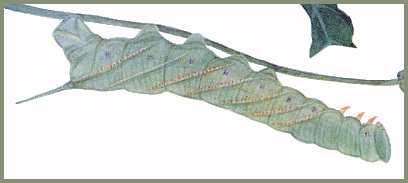
PUPA: 50--60mm, width 16mm. Similar in shape, surface and colouring to other pupae of the genus; the cremaster large, tapering gently to a simple point, rugose (Mell, 1922b).
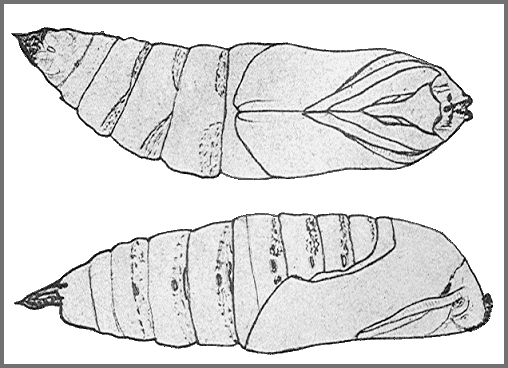
Larval hostplants. Lisea elongata, Machilus ichangensis and Phoebe (Lauraceae) in China (Mell, 1922b).
China: Zhejiang (Xianxia Ling, 800-1600m; Maogang Reservoir); Sichuan (Dahei Shan, Lixi, 1800m; Damu Shan, Mianning, 3400m); Chongqing (Simian Mountain National Scenic Resort); Yunnan (nr. Jinping, 2155m; Tengchong County, Da-Tang village; Dabaoshan, Huaping); Xizang/Tibet (Gamtog; Baxoi County; Gonjo County, Langmai (30°45'N, 98°52'E)); Hunan (Lianfeng, 1600m; Mt. Tianlong, Xinhua; Yangming Shan; Yongzhou City; Qitianling, Yizhang, 1600m; Huang Shi Zhai Liu Qi Ge); Jiangxi (Wuyi Shan, 50km SE Yingtan; Nanfeng); Fujian (Qianding; Tianbaoyan National Nature Reserve, 1500m; Wuyi Shan, nr. Zhima, 1400m); Guangdong (Lianping; Nanling National Forest Park; Shaoguan); Guanxi (Guigang City, 1140m); Hainan (Sanya, Mt. Jianfengling; Duowen Ling, nr. Lingao; Longhu Shan, Wenchang City; Wuzhi Shan, 1200-1800m; nr. Wanning City, 1288m).
From Himachal Pradesh (Smetacek, 2004a) and Uttarakhand (India (Pathania, Sunita Sharma & Gill, 2014; Bhuyan, Clark & Smetacek, 2019)) across Nepal, Sikkim (Khan & Raina, 2017), Bhutan (Irungbam & Irungbam, 2019) and northeastern India to southern China, northern Thailand, Laos and central Vietnam (Le & Vu, 2024).
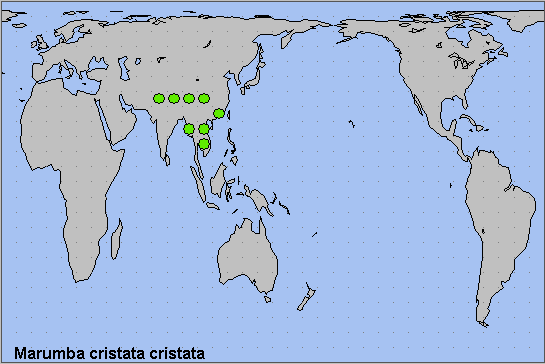
 Return to Sphingidae of the Eastern Palaearctic species list
Return to Sphingidae of the Eastern Palaearctic species list